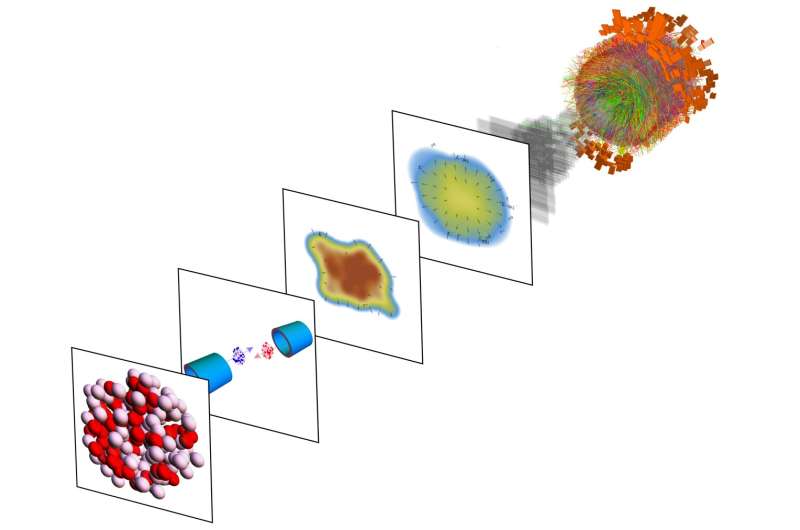This article has been reviewed according to Science X's editorial process and policies. Editors have highlighted the following attributes while ensuring the content's credibility:
fact-checked
peer-reviewed publication
trusted source
proofread
Using heavy-ion collisions at the LHC, scientists determine the thickness of neutron 'skin' in lead-208 nuclei

Lead-208 has an intriguing nucleus. It is neutron rich, containing 82 protons and 126 neutrons. One of its more interesting properties is its structure: its center is composed of both protons and neutrons, but at its edge, there is a diffuse shell of mostly neutrons. Scientists call this the neutron "skin."
Research into the neutron skin can help deepen our understanding of quantum chromodynamics, that is, how quarks and gluons (exchange particles of the strong force) in the nucleus behave. This can also have applications in astrophysics, giving insight into the structure of neutron stars—the very dense core left behind after a star between 10 and 25 times the mass of the sun has undergone a supernova explosion.
Using data from heavy-ion runs of the Large Hadron Collider, theoretical physicists at CERN have been able to determine the thickness of the lead-208 neutron skin to be 0.217±0.058 femtometers. This is in line with previous measurements obtained by other collaborations using different methods. In total, the scientists used 670 data points taken from Runs 1 and 2 of the LHC, mostly from the ALICE experiment, with some from ATLAS and CMS.
Measuring the thickness of this neutron skin is no easy feat. While the structure of the protons in the nucleus can be determined using electron scattering, neutrons have no charge, therefore they do not scatter electrons in the same way. However, neutrons are heavily affected by the strong nuclear force, which binds quarks and gluons together in the nuclei of atoms.
In the heavy-ion run of the Large Hadron Collider, beams of lead-208 are fired in opposite directions and made to collide at high energies. These nuclei are Lorentz-contracted by factors of up to 2500, meaning they are "squashed" into a flat pancake moving at close to the speed of light.
At the moment of collision, because of the immense energy and pressure in the colliding nuclei, the gluons holding the quarks inside the nucleons together are ripped apart, creating a substance called quark–gluon plasma. Quark–gluon plasma is thought to be what the universe consisted of moments after the Big Bang, and it is also theorized to be at the core of neutron stars.
As the pressure and temperature lower in the LHC, this plasma decays into particles, which can be tracked by LHC detectors to show the properties of the quark–gluon plasma. In lead-208, the distribution of the protons and neutrons determines the size and shape of the quark–gluon plasma. This allows physicists to "see" the lead-208 nucleus' structure and thus to calculate the thickness of its neutron skin.
This is the first time the thickness of the lead-208 neutron skin has been measured using the strong force. The Lead Radius Experiment (PREX) collaboration at the Thomas Jefferson National Accelerator Facility in Virginia obtained a similar result of 0.283±0.071 fm in 2021. However, this was determined using techniques using the electroweak force, as opposed to the strong force.
"What is exciting about this new determination is that it is done using only existing data and yet gives a competitive uncertainty when compared to other experimental determinations," said Wilke van der Schee, from CERN's Theoretical Physics department, one of the paper's authors. "In the future, more dedicated measurements can definitely improve the precision of the extraction from LHC data."
"The result connects the research of physicists from seemingly distant areas in an unprecedented way," adds Giuliano Giacalone, one of the paper's authors from Heidelberg University. "It brings together the topics of high-energy nuclear collisions, neutron stars and nuclear structure."
The research is published in the journal Physical Review Letters.
More information: Giuliano Giacalone et al, Determination of the Neutron Skin of Pb208 from Ultrarelativistic Nuclear Collisions, Physical Review Letters (2023). DOI: 10.1103/PhysRevLett.131.202302
Journal information: Physical Review Letters
Provided by CERN





















